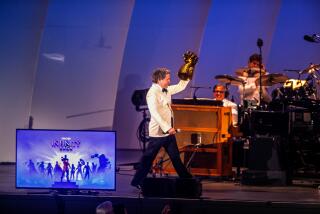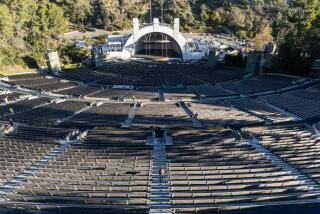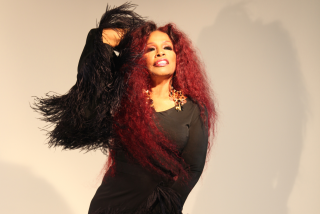He Hits It Big and Slides On Into the Bowl
- Share via
I finally got one of those calls worth the multiyear wait: We need you to play trombone at the Hollywood Bowl, said the caller.
I’ll be right there, I replied.
This was not the time to play hard to get. After all, this is a site where some of my musical heroes have shown up, from the brass players of the Philharmonic to J.J. Johnson and the jazz festival.
And while I’ve played jazz and chamber music in libraries, clubs, American Legion halls, auditoriums, churches, living rooms, hotel ballrooms and high school gyms, I’d never played the Bowl.
So on a recent, perfectly balmy Southern California evening, I--and 75 fellow musicians from the Palisades Symphony--showed up just for the kick.
For once, I would not be in one of the faraway concrete amphitheater seats well beyond the boxes.
For once, I wouldn’t need binoculars.
For once, I wouldn’t be fighting the summertime crowds.
It’s true, of course, that there was some reason behind this invitation.
It turned out that the Bowl staff was about to wake its complicated sound system and myriad speakers from winter hibernation, and they needed an orchestra--our community orchestra--to tune the system to help the season get underway.
Being a pre-warmup group just might dampen the spirits of some, but not this bunch.
From the back of the orchestra--where my people, the trombonists, congregated--the view from the raised platform offered a good perch. Not only did we have plenty of room, but music stands so solid no wind could ever knock them over. These seats even came complete with attached electric heat lamps, just in case it got a little nippy.
It was the sound, though, that caught the ear--crisp and resonant, a rich reverberating tone that carried softly and was easy to build in loudness. This is no small thing. Musicians always have to adjust to their surroundings; it’s a relief when one does not have to fight them.
Just being on stage seemed to provide many musicians with a kind of validation.
Howard, the oboist, said, “Forty years ago, I thought this is where I was going to end up,” before ceding a life as a professional musician. “I’m glad I came back to music to be here.”
*
A Carl Maria von Weber overture to the opera “Oberon,” some Edouard Lalo “Symphonie Espagnole” and the Symphony No. 1 by Johannes Brahms all drifted by.
The orchestra was playing well; the sound of the violin soloist soared, the strings blended, the woodwinds sounded precise. Some of the music called for delicateness, some for well-articulated brashness. We got it all in a full performance for the mostly missing.
The playing, even at its intense musical moments, was relaxed and fun.
Conductor Joel Lish, donning a black rehearsal turtleneck, went up into the seats to listen.
“It sounds completely different out there,” he declared, to some laughter. Out there, sounds blend and fill in from what can be heard onstage.
*
One rule of thumb for trombone players in the orchestra is that there is always a wait. The strings may keep charging through the concert; our sound is saved for punctuation or for when Romantic composers want to bring on the image of glory and salvation.
So, I got a chance to talk with the sound techs. A crew of seven was working this evening, most seasonal employees, as well as a sound designer and Mike Ferber, the production supervisor.
From a 12-foot array of glinting electronic switches and gadgetry, the technicians fine-tuned such things as the microscopic delays in speakers.
And are there speakers.
Huge speakers at the sides of the stage, of course, as well as a ring of small speakers aimed at the box seats and a row of three above the lights. There are even speakers behind every hedge throughout the amphitheater.
Ferber explained that those speakers farther from the stage need to sound slightly later to match the time it takes for sound to travel from the stage.
“We try to preserve the natural sound as much as possible,” he said.
Those huge spheres we see when looking in the direction of the Bowl stage work to make the sound understandable and balanced to those onstage. They do little for what the audience hears. “If the sound coming off the stage is good, we will have good projected sound,” said Ferber.
Sound, it turns out, is pretty fickle. Changes in temperature, wind, weather will affect how sound travels, and adjustments need to be made nightly.
So, too, do fireworks, apparently, which affect some musicians as well as machines.
“We’ve had a few foreign orchestras here on a fireworks night who had no idea what was happening when the explosions started,” Ferber said.
He thanked us for agreeing to play.
I asked him to remind some of the visiting musical pooh-bahs just who made it possible for things to sound right.
*
Onstage, the Brahms neared its triumphal ending--a second time, just to make sure the techs had it right.
Brass bells lifted; notes shown as loud could, finally, really be played loud. Smiles all around. I noticed the bass players were sharing a small flask.
As we packed up our instruments, I took a last look out to the audience: of the 15,000 seats, about 14,950 were empty.
It was a nice view from this vantage point. I looked at all the places I’ve sat and silently considered that it sounded a helluva lot better right onstage.
And with that, it was over, except for one last surprise: It was the first time that I actually could leave the Bowl without a hassle over parking.
More to Read
The biggest entertainment stories
Get our big stories about Hollywood, film, television, music, arts, culture and more right in your inbox as soon as they publish.
You may occasionally receive promotional content from the Los Angeles Times.










